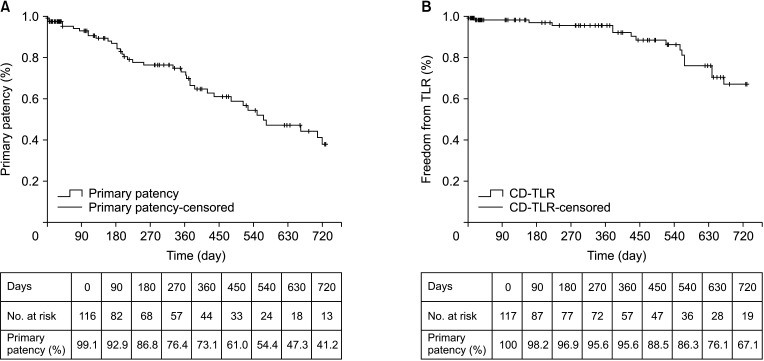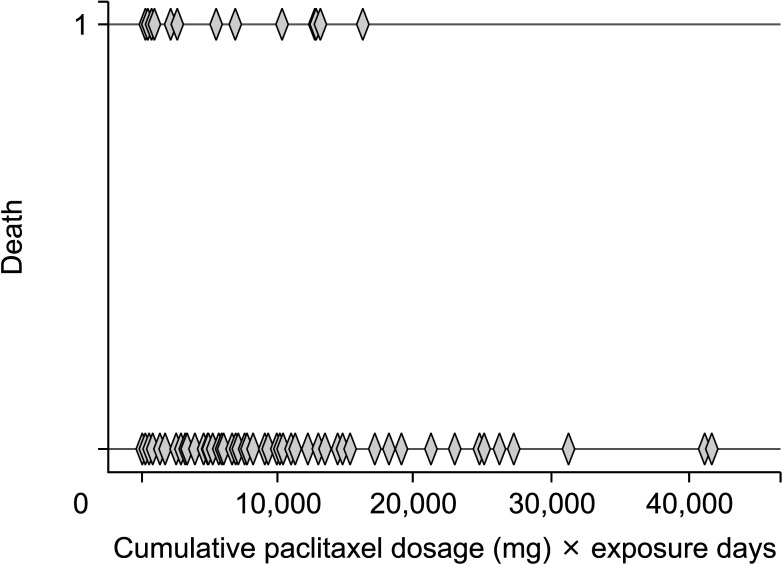Ann Surg Treat Res.
2021 Aug;101(2):120-128. 10.4174/astr.2021.101.2.120.
Multiple drug-coated balloons can be used effectively for peripheral arterial disease including long femoropopliteal lesions
- Affiliations
-
- 1Division of Vascular and Endovascular Surgery, Department of Surgery, Pusan National University Yangsan Hospital, Yangsan, Korea
- 2Division of Vascular and Endovascular Surgery, Department of Surgery, Pusan National University Hospital, Busan, Korea
- 3Research Institute for Convergence of Biomedical Science and Technology, Pusan National University Yangsan Hospital, Yangsan, Korea
- KMID: 2519005
- DOI: http://doi.org/10.4174/astr.2021.101.2.120
Abstract
- Purpose
Drug-coated balloons have shown successful results in treating peripheral arterial occlusive disease. However, using multiple balloons for long femoropopliteal lesions (>15 cm) remains challenging; their safety and efficacy need to be explored. Therefore, we aimed to evaluate the outcomes of multiple drug-coated balloons for long femoropopliteal lesions in terms of the primary patency, freedom from clinically-driven target lesion revascularization, and mortality.
Methods
Between April 2015 and September 2018, 96 patients (117 limbs) who underwent balloon angioplasty using at least 2 drug-coated balloons for femoropopliteal lesions were retrospectively reviewed. Lesions were classified as TransAtlantic Inter-Society Consensus (TASC) classification C or D. The outcomes were analyzed using Kaplan-Meyer analysis.
Results
The mean age of 96 enrolled patients was 70.8 ± 9.8 years, and 83 patients were males (86.5%). Critical limbthreatening ischemia was found in 29 cases (24.8%). The mean lesion and drug-coated balloon lengths per limb were 292.3 ± 77.8 mm and 325.0 ± 70.2 mm, respectively. The technical success rate was 99.2%. A total of 82.1% were followedup for more than 6 months. The primary patency rates at 12 and 24 months were 71.4% and 41.7%, respectively; freedom from clinically-driven target lesion revascularization rates were 96.4% and 71.0% at 12 and 24 months, respectively. The Kaplan-Meier estimate of the 2-year overall cumulative mortality rate was 20.8%. All identified mortalities appeared to be less associated with paclitaxel.
Conclusion
Drug-coated balloons can be effectively used without drug-related mortality, even for long lesions, such as TASC classification C or D femoropopliteal lesions.
Figure
Reference
-
1. Tepe G, Micari A, Keirse K, Zeller T, Scheinert D, Li P, et al. Drug-coated balloon treatment for femoropopliteal artery disease: the chronic total occlusion cohort in the IN.PACT Global Study. JACC Cardiovasc Interv. 2019; 12:484–493. PMID: 30846089.2. Laird JR, Schneider PA, Tepe G, Brodmann M, Zeller T, Metzger C, et al. Durability of treatment effect using a drug-coated balloon for femoropopliteal lesions: 24-month results of IN.PACT SFA. J Am Coll Cardiol. 2015; 66:2329–2338. PMID: 26476467.3. Laird JR, Yeo KK. The treatment of femoropopliteal in-stent restenosis: back to the future. J Am Coll Cardiol. 2012; 59:24–25. PMID: 22192664.4. Torii S, Kolodgie FD, Virmani R, Finn AV. IN.PACT™ Admiral™ drug-coated balloons in peripheral artery disease: current perspectives. Med Devices (Auckl). 2019; 12:53–64. PMID: 30858737.5. Shin SH, Kwon SH, Cho JH, Ahn HJ, Oh JH, Park HC. Outcomes of bypass surgery versus endovascular therapy for TASC II C and D femoro-popliteal lesions in patients with chronic limb ischemia. Korean J Vasc Endovasc Surg. 2010; 26:90–97.6. Baril DT, Chaer RA, Rhee RY, Makaroun MS, Marone LK. Endovascular interventions for TASC II D femoropopliteal lesions. J Vasc Surg. 2010; 51:1406–1412. PMID: 20385464.
Article7. Norgren L, Hiatt WR, Dormandy JA, Nehler MR, Harris KA, Fowkes FG, et al. Inter-Society Consensus for the Management of Peripheral Arterial Disease (TASC II). J Vasc Surg. 2007; 45 Suppl S:S5–S67. PMID: 17223489.
Article8. Micari A, Nerla R, Vadalà G, Castriota F, Grattoni C, Liso A, et al. 2-Year results of paclitaxel-coated balloons for long femoropopliteal artery disease: evidence from the SFA-long study. JACC Cardiovasc Interv. 2017; 10:728–734. PMID: 28385412.9. Jaff MR, Rosenfield K, Scheinert D, Rocha-Singh K, Benenati J, Nehler M, et al. Drug-coated balloons to improve femoropopliteal artery patency: rationale and design of the LEVANT 2 trial. Am Heart J. 2015; 169:479–485. PMID: 25819854.
Article10. Zeller T, Rastan A, Macharzina R, Tepe G, Kaspar M, Chavarria J, et al. Drug-coated balloons vs. drug-eluting stents for treatment of long femoropopliteal lesions. J Endovasc Ther. 2014; 21:359–368. PMID: 24915582.
Article11. Du X, Wang F, Wu DM, Zhang MH, Jia X, Zhang JW, et al. Comparison between paclitaxel-coated balloon and standard uncoated balloon in the treatment of femoropopliteal long lesions in diabetics. Medicine (Baltimore). 2019; 98:e14840. PMID: 30921183.
Article12. Xu Y, Jia X, Zhang J, Zhuang B, Fu W, Wu D, et al. Drug-coated balloon angioplasty compared with uncoated balloons in the treatment of 200 Chinese patients with severe femoropopliteal lesions: 24-month results of AcoArt I. JACC Cardiovasc Interv. 2018; 11:2347–2353. PMID: 30448170.13. Roh JW, Ko YG, Ahn CM, Hong SJ, Shin DH, Kim JS, et al. Risk factors for restenosis after drug-coated balloon angioplasty for complex femoropopliteal arterial occlusive disease. Ann Vasc Surg. 2019; 55:45–54. PMID: 30118857.
Article14. Jia X, Zhang J, Zhuang B, Fu W, Wu D, Wang F, et al. Acotec drug-coated balloon catheter: randomized, multicenter, controlled clinical study in femoropopliteal arteries: evidence from the AcoArt I trial. JACC Cardiovasc Interv. 2016; 9:1941–1949. PMID: 27659572.15. Conte MS, Bradbury AW, Kolh P, White JV, Dick F, Fitridge R, et al. Global vascular guidelines on the management of chronic limb-threatening ischemia. J Vasc Surg. 2019; 69(6S):3S–125S. PMID: 31159978.16. Katsanos K, Spiliopoulos S, Kitrou P, Krokidis M, Karnabatidis D. Risk of death following application of paclitaxel-coated balloons and stents in the femoropopliteal artery of the leg: a systematic review and meta-analysis of randomized controlled trials. J Am Heart Assoc. 2018; 7:e011245. PMID: 30561254.
Article17. Schmidt A, Piorkowski M, Görner H, Steiner S, Bausback Y, Scheinert S, et al. Drug-coated balloons for complex femoropopliteal lesions: 2-year results of a Real-World Registry. JACC Cardiovasc Interv. 2016; 9:715–724. PMID: 27056311.18. TASC Steering Committee. Jaff MR, White CJ, Hiatt WR, Fowkes GR, Dormandy J, et al. An update on methods for revascularization and expansion of the TASC lesion classification to include below-the-knee arteries: a supplement to the inter-society consensus for the management of peripheral arterial disease (TASC II). Vasc Med. 2015; 20:465–478. PMID: 26268268.
Article19. Micari A, Brodmann M, Keirse K, Peeters P, Tepe G, Frost M, et al. Drug-coated balloon treatment of femoropopliteal lesions for patients with intermittent claudication and ischemic rest pain: 2-year results from the IN.PACT Global Study. JACC Cardiovasc Interv. 2018; 11:945–953. PMID: 29798770.20. Lai Z, Zhang X, Shao J, Li K, Fang L, Xu L, et al. One-year results of drug-coated balloons for long and occlusive femoropopliteal artery disease: a single-arm trial. BMC Cardiovasc Disord. 2020; 20:65. PMID: 32028896.
Article21. Teymen B, Akturk S, Akturk U, Tdjani M. Comparison of drug-eluting balloon angioplasty with sel f-expanding interwoven nitinol stent deployment in patients with complex femoropopliteal lesions. Vascular. 2018; 26:54–61. PMID: 28708023.22. Phillips JA, Falls A, Kolluri R, Whipp A, Collins C, Mohir-Sadaai S, et al. Full drug-eluting stent jacket: two-year results of a single-center experience with Zilver PTX stenting for long lesions in the femoropopliteal arteries. J Endovasc Ther. 2018; 25:295–301. PMID: 29544372.
Article23. Schillinger M, Sabeti S, Loewe C, Dick P, Amighi J, Mlekusch W, et al. Balloon angioplasty versus implantation of nitinol stents in the superficial femoral artery. N Engl J Med. 2006; 354:1879–1888. PMID: 16672699.
Article24. Schneider PA. Evolution and current use of technology for superficial femoral and popliteal artery interventions for claudication. J Vasc Surg. 2017; 66:916–923. PMID: 28842077.
Article25. Ueda M, Becker AE, Tsukada T, Numano F, Fujimoto T. Fibrocellular tissue response after percutaneous transluminal coronary angioplasty: an immunocytochemical analysis of the cellular composition. Circulation. 1991; 83:1327–1332. PMID: 2013150.
Article26. Kim MS, Joo YS, Park KH. Results of simultaneous hybrid operation in multi-level arterial occlusive disease. J Korean Surg Soc. 2010; 79:386–392.
Article
- Full Text Links
- Actions
-
Cited
- CITED
-
- Close
- Share
- Similar articles
-
- CORRIGENDUM: Multiple drug coated balloons can be used effectively for peripheral arterial disease including long femoropopliteal lesions
- Association of mortality with drug-coated devices in femoropopliteal artery based on the nationwide data
- Improving the Outcomes of Complex Lesions of the Femoropopliteal Artery Using Atherectomy and Drug Coated Balloon
- Effectiveness of Atherectomy and Drug-Coated Balloon Angioplasty in Femoropopliteal Disease: A Comprehensive Outcome Study
- Drug-Coated Balloon Treatment for De Novo Coronary Artery Disease



